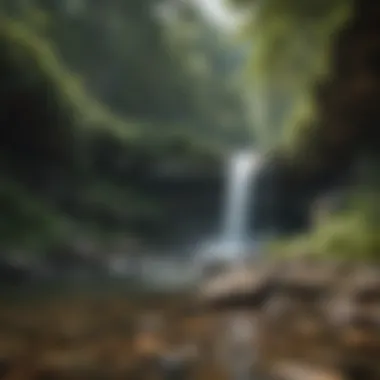Exploring the Majestic Waterfalls of the Great Smoky Mountains


Intro
The Great Smoky Mountains National Park is a treasure trove of natural beauty, home to some of the most breathtaking waterfalls in the United States. Each waterfall boasts its own unique characteristics, from cascading torrents to serene pools, attracting visitors all year. The diverse landscapes that enhance these falls contribute to their magnificent appeal.
This guide will delve into the waterfalls found in this stunning national park. It emphasizes not just the visual spectacle, but also the ecological implications and accessibility of these natural features. Whether you are a dedicated hiker, a family seeking adventure, or simply a nature enthusiast, the waterfalls of the Great Smoky Mountains offer a profound connection to the landscape.
From popular sites like Laurel Falls to hidden gems like Mouse Creek Falls, each location presents an opportunity to experience the soothing sounds and sights of moving water. In addition, understanding the best time to visit, safety precautions, and the role of these waterfalls in the local ecosystem will enhance your appreciation of this remarkable natural environment.
Animal Profile
General Overview
The Great Smoky Mountains are also home to a wide array of wildlife, some of which depend on the aquatic ecosystems surrounding these waterfalls. Animals like black bears, deer, and a variety of bird species thrive in the rich habitats found near these water features. Understanding the relationship between these animals and their environment is crucial.
Habitat and Distribution
Waterfalls create unique microhabitats which are moist and shaded. This environment supports various life forms. For instance, the aquatic insects found in the pools below waterfalls play a significant role in the food chain. Fish such as brook trout can also be found in some of the colder streams, illustrating the variety of life sustained in these ecosystems. Their distribution is often linked to the elevation and temperature variations within the park.
Fascinating Facts
Unique Traits and Adaptations
The ecosystem surrounding waterfalls is dynamic. Wildlife here has evolved in remarkable ways to adapt to the specific conditions. For instance, otters are agile swimmers, using their speed to navigate the challenging waters.
Historical and Cultural Significance
Many waterfalls in the park have historical significance. They have been sites for cultural gatherings and are central to local folklore. For indigenous tribes, these water sources were sacred, often serving as gathering places for ceremonies and community events.
Conservation Status
Current Population Trends
The ongoing conservation efforts in the Great Smoky Mountains help maintain the delicate balance of these ecosystems. Monitoring animal populations near waterfalls shows trends that can indicate environmental health. This data is crucial for understanding how changes in climate or human impact may influence wildlife.
Threats and Challenges
Despite conservation initiatives, waterfalls face threats from pollution, invasive species, and climate change. Wetland habitats near waterfalls are particularly vulnerable. The introduction of non-native plants can disrupt local ecosystems. Efforts should continue to combat these challenges and protect the unique biodiversity present in the park.
Care Tips for Pet Owners
Basic Needs and Requirements
When visiting the waterfalls, pet owners need to take precautions. Waterfalls can be dangerous for pets, particularly because of steep terrains and swift currents. Ensure pets are leashed and supervised at all times.
Health and Wellness Tips
Bringing enough water for your pet is crucial, as hiking can be strenuous. Keep an eye on signs of fatigue or stress. If temperatures rise, consider taking breaks in shaded areas to minimize heat exposure.
By understanding the complexities of these natural ecosystems, visitors can enhance their experience and contribute to the preservation of these cherished landscapes.
Prelims to the Waterfalls
Waterfalls have a unique charm and ecological role within the Great Smoky Mountains National Park. They are not just visual spectacles; they embody the essence of the natural world intertwined with human exploration. This article emphasizes their importance, accessibility, and ecological significance. Understanding waterfalls sets the stage for a deeper appreciation of the park's intricate ecosystems.


Significance of Waterfalls in the Park
Waterfalls are vital for various reasons. Firstly, they contribute to the park's biodiversity. Many species depend on the specific habitats created by these cascading waters. They also shape the surrounding landscapes, creating microclimates that support lush vegetation and diverse animal populations. Waterfalls also provide recreational opportunities for visitors, serving as scenic backdrops for hiking and photography.
Further, these natural features hold cultural significance for many indigenous communities. Historically, they have been sites of spiritual importance and resource gathering. The unique ecosystems that develop around waterfalls help maintain the health of the larger park environment by filtering water and supporting aquatic life. Thus, their presence in the Great Smoky Mountains is indispensable.
General Overview of the Great Smoky Mountains
The Great Smoky Mountains, straddling the border between North Carolina and Tennessee, are rich in biodiversity and remarkable scenery. This area encompasses over 800 square miles of protected land, making it one of the largest temperate rainforests in North America. The park is renowned for its stunning vistas, diverse wildlife, and extensive hiking trails that meander through vast forested areas.
One notable feature of the Great Smoky Mountains is its elevation variation, leading to distinct climates and ecosystems. This variation contributes to the wide array of flora and fauna found within the park. Visitors can encounter everything from majestic oaks to vibrant wildflowers, and the wildlife includes black bears, deer, and numerous bird species. The waterfalls within the park enhance the overall experience for those who wander its trails, reflecting both its beauty and ecological complexity.
Major Waterfalls to Visit
The Great Smoky Mountains National Park is home to numerous waterfalls that serve as focal points for visitors. These waterfalls not only enhance the park's breathtaking beauty but also provide vital ecological functions. The major waterfalls in this guide are not just picturesque; they offer various experiences, from challenging hikes to easily accessible viewpoints. Understanding the characteristics of each falls can guide visitors in making informed decisions about their excursions.
Laurel Falls
Trail Information
Laurel Falls is one of the most popular waterfalls in the park. The trail to reach it is relatively short, at about 2.6 miles round trip. This feature makes it accessible for families and novice hikers. The path includes a well-maintained, paved surface, catering to visitors of all ages and abilities. The beauty of Laurel Falls lies in the cascade created by the stream, plunging over large boulders surrounded by lush greenery. However, it is essential to be mindful of the number of hikers during peak seasons as it can get crowded, reducing the tranquility of the experience.
Parking and Accessibility
Parking for Laurel Falls can be limited, particularly during weekends and holidays. The primary parking area is just before the trail entrance. Visitors should arrive early to secure a spot. Accessibility is a significant aspect here; the paved path accommodates strollers and is friendly to those with mobility challenges. Despite its scarcity, nearby areas are also worth exploring if the main parking fills up.
Best Times to Visit
The best times to visit Laurel Falls are during spring and fall. These seasons offer stunning foliage and floral presentations, enhancing the hike’s visual appeal. Summer often leads to larger crowds, while winter presents unique challenges due to icy paths. Therefore, it’s recommended to plan visits in early morning or late afternoon to capture serene moments at the waterfall.
Abrams Falls
Trail Difficulty
Abrams Falls is admired for its power and beauty. The hike is 5 miles round trip and is rated as moderate to strenuous due to its rocky paths and elevation change. The unique aspect of this trail is the scenic views it offers alongside lovely wildflowers. It attracts those looking for a fulfilling adventure. However, newcomers need to prepare adequately to handle the trail's demands.
Wildlife Viewing
Wildlife viewing is a delight on the Abrams Falls trail. The area is frequented by deer, wild turkeys, and various bird species. Visitors can recount experiences of spotting these animals just off the trail or near the waterfall itself. The richness of the ecosystem here makes it a fascinating destination for nature watchers. However, always respect wildlife and maintain a safe distance.
Scenic Perspectives
Abrams Falls offers numerous vantage points along the hike. The views of the falls themselves can be extraordinarily rewarding, especially after rainfall when the water flow is plentiful. Each perspective provides a unique angle for photography and appreciation of the natural setting. Be mindful of the rocky outcroppings, as they can be slippery and dangerous.
Grotto Falls
Unique Features
Grotto Falls is distinctive because visitors can walk behind the waterfall itself. This unique feature allows for an unusual experience of seeing flowing water from behind the cascade. The 2.6-mile round trip hike is moderate in difficulty, making it accessible. This area tends to be quieter than others, appealing to those seeking a more secluded experience.
Family-Friendly Options
Grotto Falls features an opportunity for family outings. The trails are wide and manageable for kids, and the waterfall’s backdrop makes for exciting exploration. Parents should supervise younger children closely near the falls. It is also a great learning experience about nature as families can enjoy the surrounding flora and fauna together.


Photography Opportunities
Photography is abundant at Grotto Falls. The chance to capture images from behind the waterfall provides a unique perspective. Additionally, the surrounding landscape enriches the photographic experience. Remember to bring proper gear and protect your equipment from mist and possible water splashes.
Rainbow Falls
Ecosystem Impact
Rainbow Falls plays a critical role in its ecosystem. The falls feed into a significant watershed, supporting various aquatic life. This ecological significance enhances the importance of preserving such areas. Understanding the balance between nature and human activity is crucial to maintaining these cherished locations.
Water Flow Variations
The flow of water at Rainbow Falls varies with seasons and rainfall. This variability can significantly impact the waterfall's appearance. During spring rains, the waterfall showcases its full force, while summer and fall might present a gentler flow. Visitors should check current conditions to optimize their experience and photography.
Access Points
Access points to Rainbow Falls can be challenging. The main trailhead requires a moderately strenuous hike. It's recommended to prepare for the elevation changes. Be cautious when attempting to traverse areas during rainy weather, as trails can become muddy and slippery.
Hidden Waterfalls
Hidden waterfalls in the Great Smoky Mountains offer a different perspective compared to their more famous counterparts. These waterfalls are often less crowded, providing tranquility for those who venture to find them. Exploring these secluded spots allows visitors to engage with nature more intimately. This article delves into two specific hidden waterfalls, Little River Falls and Mouse Creek Falls, emphasizing their unique characteristics and visitor experiences.
Little River Falls
Secluded Access
Little River Falls can be hard to find for those unprepared. Its remote location requires effort to reach. This makes it a less popular choice compared to other waterfalls. However, this seclusion is what attracts many visitors. It allows for a peaceful escape from the hustle and bustle of more known spots. The trail to access it is usually quiet, creating an environment that fosters reflection. Visitors can enjoy the sounds of nature, free from distractions. The journey adds to the overall experience, making the final destination feel even more rewarding.
Surrounding Flora
The flora surrounding Little River Falls is diverse and vibrant. Visitors can observe a mix of native plants, trees, and wildflowers. This botanical richness enhances the visual experience for anyone visiting. Each season offers different displays. In spring, blooming flowers cover the area, while fall brings colorful leaves. The environment around the waterfall contributes to its charm. This variety also attracts various wildlife, enriching visitor experience. However, accessibility might be limited. Some areas may be steep or challenging to navigate due to dense vegetation.
Visitor Experience
Visiting Little River Falls offers a unique experience. The tranquility of the setting encourages visitors to connect with nature. Many visitors find this waterfall ideal for meditation or simply enjoying solitude. The secluded environment allows for deeper contemplation. However, the isolation can also pose challenges for those seeking social interactions. Facilities are limited, so planning is crucial for comfort. Carrying essentials is necessary to enhance the visit. Overall, Little River Falls provides an experience distinct from busier attractions.
Mouse Creek Falls
Access Challenges
Mouse Creek Falls presents more access challenges than other waterfalls in the park. The trails can be uneven and require careful navigation. Some visitors may find the hike difficult, deterred by rugged paths and potential obstructions. Yet, overcoming these challenges rewards the adventurer with stunning views. Few make the effort to reach this gem, keeping it less crowded. This lessened foot traffic offers a sense of exploration. Those willing to face the challenges often appreciate the result, a beautiful hidden waterfall surrounded by lush greenery.
Natural Beauty
The natural beauty surrounding Mouse Creek Falls is captivating. The waterfall itself cascades over rocks into a serene pool. This setting creates a perfect atmosphere for photographers and nature lovers. The surrounding area bursts with life, from the greenery to the wildlife present. Birds and small animals can often be seen or heard near this location. This contributes to the overall experience of immersion in nature. The challenge of reaching it only serves to enhance appreciation of its beauty.
Photographic Possibilities
Mouse Creek Falls provides numerous photographic possibilities for visitors. Photographers can capture the essence of nature in its purest form. The striking visuals create a variety of scenes for all levels of skill. Early morning or late afternoon light can yield stunning photos, with gentle sunlight cascading over the falls. However, be mindful of your surroundings, as these areas can be slippery. Careful planning with appropriate gear increases the chances of capturing great shots. The opportunity to document such rare beauty is one of the primary reasons photographers seek out this waterfall.
Ecological Importance of Waterfalls
Waterfalls in the Great Smoky Mountains are not just beautiful features of the landscape; they play a vital role in the ecosystem. Their presence contributes significantly to local biodiversity and helps in the maintenance of healthy watersheds. Understanding the ecological importance of these waterfalls allows us to appreciate their role beyond aesthetic value.


Role in Local Biodiversity
Waterfalls create specific habitats that support a diverse array of flora and fauna. The constant movement of water prevents the establishment of certain plant species, favoring the growth of those that thrive in moist, rocky environments.
Key Points About Waterfalls and Biodiversity:
- Niche Habitats: Waterfalls contribute to a mosaic of microhabitats, each supporting unique life forms. For instance, the cool mist and spray near the base of a waterfall attract moisture-loving plants and insects.
- Endemic Species: Some organisms depend exclusively on waterfall ecosystems. Fish like the brook trout rely on clean, cold water that these waterfalls provide, creating resting areas and suitable breeding grounds.
- Pollination and Seed Dispersal: The diverse plant life around waterfalls often draws pollinators. This process is essential for maintaining biodiversity and ensuring the reproduction of various plant species.
In summary, waterfalls foster ecosystems that nurture a wealth of species, reinforcing the need for conservation efforts in these areas.
Waterfalls and Watersheds
Waterfalls are also integral to the health of watersheds within the Great Smoky Mountains. They influence water quality and are key players in the hydrological cycle.
Considerations Regarding Watersheds:
- Water Regulation: Waterfalls help regulate the flow of streams and rivers, controlling erosion and sediment transport. This regulation is crucial for maintaining the structure and function of the local ecosystem.
- Filtration: As water cascades over rocks, it undergoes natural filtration. This process removes impurities and contributes to the overall water quality that supports both aquatic and terrestrial life.
- Nutrient Cycling: Waterfalls assist in the cycling of nutrients, as organic materials are transported down the waterways. This movement sustains various ecosystems downstream, benefiting both aquatic species and those that depend on them.
Waterfalls serve as vital components of the hydrological system, promoting ecological balance and sustainability within their watersheds.
The interplay between waterfalls and watersheds illustrates the complexity of these ecosystems. By understanding their ecological importance, we highlight the need to protect and preserve the waterfalls of the Great Smoky Mountains.
Safety Considerations
Staying Safe on the Trails
Waterfalls often attract many visitors, leading to popular yet sometimes challenging trails. When hiking, it is important to be aware of trail conditions and potential hazards. Here are several tips to ensure safety:
- Wear appropriate footwear: Hiking boots with good traction can help prevent slips and falls on rocky or uneven terrain.
- Stay on designated paths: Straying off marked trails can lead to injury or damage to the ecosystem.
- Carry a map: Good navigation helps avoid getting lost in the vast landscape of the Smokies.
- Travel in groups: There is safety in numbers. Group hiking can provide assistance during emergencies.
Moreover, potential wildlife encounters should be considered. Bears, snakes, and other animals inhabit the area. Be alert and take necessary precautions to minimize risks. If an encounter occurs, remember to remain calm and keep your distance.
Understanding Weather Impacts
Weather changes rapidly in the Great Smoky Mountains, affecting both trail safety and the waterfall experience. Knowing the weather patterns is vital:
- Check forecasts: Always review local weather conditions before heading into the park. Conditions such as rain can cause trails to become slippery and increase the chance of flash flooding near waterfalls.
- Dress appropriately: Layers are essential as temperatures can vary greatly between day and night.
- Avoid hiking during storms: Thunderstorms can lead to hazardous situations. If thunderstorms are predicted, postpone your hike to a safer day.
"Being prepared for changing weather can turn a potentially dangerous situation into a manageable one."
Visitors should be aware of the signs of inclement weather, such as increasing clouds or dropping temperatures. Taking decisive action—like turning back or seeking shelter—can prevent dangerous situations as conditions shift unexpectedly. By understanding both the trails' physical demands and the unpredictable nature of mountain weather, visitors can better ensure a safe and enjoyable experience in the beauty of the Great Smoky Mountains.
Culmination
Reflection on Nature��’s Splendor
The waterfalls in the Great Smoky Mountains National Park serve as a profound reminder of nature’s beauty and power. Each waterfall offers not just an aesthetic appeal, but also an opportunity to reflect on the ecosystem’s intricate balance. The sound of cascading water, the sight of sunlight glistening off rocks, and the lush surroundings inspire awe in those who visit. These natural wonders enhance our appreciation of the environment, encouraging a deeper connection with the earth.
In witnessing the waterfalls, one can observe the role they play in shaping the landscape and supporting diverse forms of life. The continuous flow of water creates not only picturesque scenes but also vital habitats for various species. Each waterfall embodies a unique ecosystem that is important for maintaining biodiversity in the region.
"Waterfalls are the earth's laughter; they remind us of the joy and serenity that nature brings."
Encouragement to Explore
Exploring the waterfalls in the Great Smoky Mountains is an invitation to embrace the wilderness. The trails leading to these natural displays offer a range of experiences, varying from easy walks suitable for families to challenging hikes for the more ambitious. Whichever path one chooses, there exists an opportunity to encounter the area's rich flora and fauna.
Visiting these waterfalls promotes not only physical activity but also mental rejuvenation. Nature has an innate ability to reduce stress and enhance overall well-being. Individuals are encouraged to plan trips to see these magnificent sites, ideally during different seasons to witness the diverse transformations that occur.
Before embarking on this journey, it is essential to prepare adequately. Check trail conditions, weather forecasts, and safety guidelines to ensure a smooth experience. Engaging with the natural world through such exploration fosters respect and stewardship for the environment, making it crucial to leave no trace behind.















